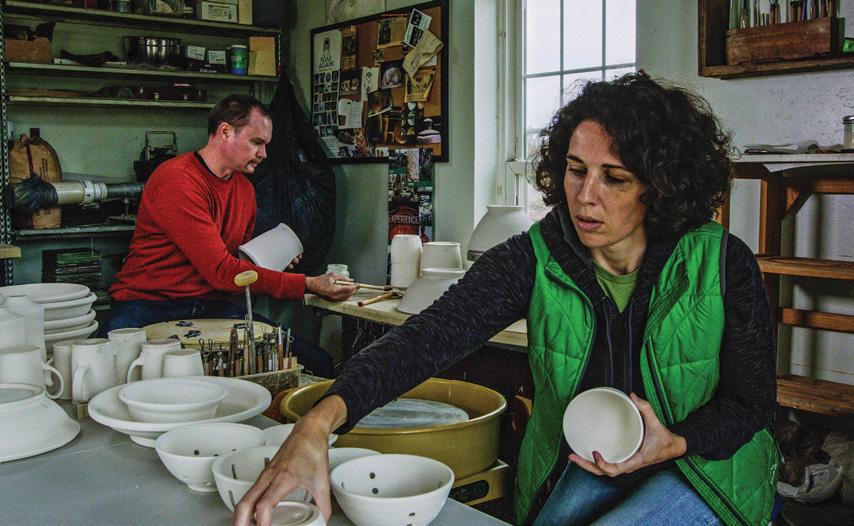
4 minute read
WK&T Connection July/August 2020
Turning over an old leaf
Family farm provides career and passion for Galloways
Story by JOHN CLAYTON
Bob Galloway is still working the Graves County farmland his grandfather and father turned before him. The once-small farm has grown from just a few acres to more than 370 with tobacco, corn, soybean and newly added hemp crops.
Even so, it is still very much a family farm — in more ways than one.
Galloway, who owns and operates the farm, has help from a host of other Galloways: his wife, Kim; his father, Bobby; and his uncle, Kenneth. The last two are both retired Graves County educators and administrators. His 16-year old daughter, McKenna, can occasionally be found behind the wheel of a tractor, and 7-yearold daughter Kennedy is “in charge.” His younger brother, Jonathan, also helps whenever he can. Then, there’s the extended family. “My employees – the guys that work for us – they’re almost like family,” Galloway says of the farm workers who annually trek to Kentucky each crop season. “They put their lives on hold and come up here and live with us for six or seven months and help us make a living. You get really close to those guys and get to know their families, their kids and their parents. That’s one of the major aspects of it.”
COMING HOME
Galloway’s grandmother owned the place. He found a home there on the farm, working in the fields with his father and uncle. After four years at Murray State, where he majored in agriculture business, he returned and decided to dig his roots deeper on the family farm.
Now 39, he still does the work and lives there, too, with his own wife and kids. From what started out as just a few acres in Sedalia, the Galloways have grown the place, along with their crops. The farm now has about 60 acres of tobacco and 300 acres of corn and soybeans, as well as about 12 acres of hemp, which Galloway planted for the first time this past year. “We started with the farm here, and we purchased more land and built it up over the years,” he says.
Galloway has wanted to be a farmer since he was a little boy. There was something about working in the fields that he enjoyed. But tobacco is the crop he finds the most challenging and the most rewarding as a farmer. That’s why he started out with 6 acres and now has 10 times that number.
“It’s not a corn or a bean that you just put in the field, spray it a couple of times and go harvest,” he says. “It’s something that you’ve got to look at every day, and there are ways to manipulate it to try to increase your production, whether it be through your labor force or your chemical programs. It’s just more of a challenge with the market.”
Tobacco is still a viable cash crop for the Galloways, even though government quotas have changed, as well as smoking habits across the country and the world. “It’s been tougher from that angle than it was probably 40 or 50 years ago,” Galloway says.
He recognized the changing market early on and began to diversify his crops, using a larger portion of his land for corn and soybeans and adding the dozen acres of hemp this past year as he attempted to take advantage of what appeared to be a burgeoning new market.
“We basically had all the equipment that we needed for hemp, much like the tobacco,” Galloway says. “It has to be hand cut like tobacco, and we had the barns, so there wasn’t much of a changeover at all as far as a learning curve. It’s a totally different crop, but as far as the means of producing it, we were set up to do it, and that’s why it is a good fit for us in this area. We’ve got the labor, and we’ve got the equipment.”
The new crop was a success in the field, but Galloway found the market to be more saturated and less burgeoning than he had been led to believe. By springtime, his first hemp crop remained unsold. Even so, Galloway says he isn’t ready to give up on it.
“Hopefully, the market will continue to expand,” he says. “We had hopes for it, and we still have hopes for it. We need something else to keep this going and keep this economy going, especially in our region and our rural area. Tobacco has been huge and has brought a huge amount of money into these counties, but it’s dwindled down over the years. We need something to replace it.”
If the market rebounds, Galloway would like to see 75% tobacco and 25% hemp on the farms in addition to the row crops of soybeans and corn.
Galloway says he perhaps should have diversified his crops even more since taking over the farm out of college nearly two decades ago, but growing tobacco is still his passion and will continue to be.
“Tobacco has always been here, especially that dark-fire tobacco, which is more of a process than the barley and stuff — you’ve got the curing process and the firing process,” he says. “It’s taught to you, and you learn it as you grow. It’s always different, but there’s still basics that you just learn. There’s a challenge to it to be able to make high quality and keep your production up along with the quality.”

Workers harvest tobacco on the family-owned farm.


